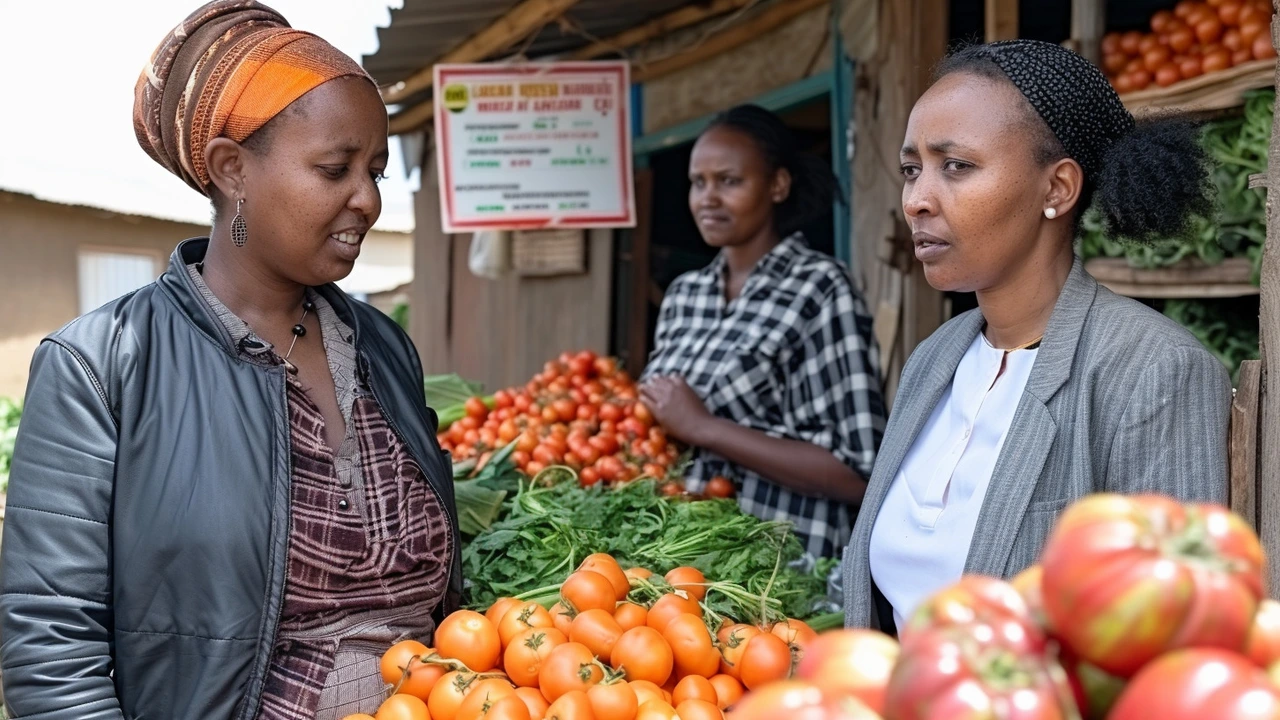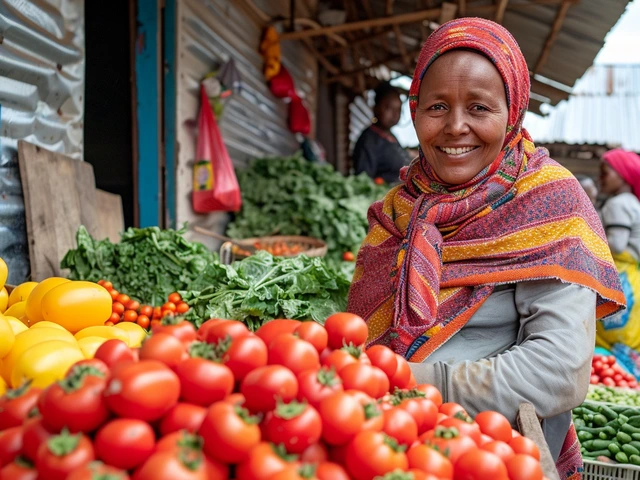When you walk through the markets of Addis Ababa or any other city across Ethiopia, one pressing question might catch your attention: Why is food so expensive here? Despite being a cornerstone of human sustenance, food prices in Ethiopia have continued to climb, posing serious concerns for everyday livelihoods.
To begin unwrapping this complex issue, it's essential to trace back to the historical economic and agricultural landscapes of Ethiopia. Comprehending these foundations can shed light on the existing challenges and perhaps guide us toward viable solutions.
- Historical Context
- Economic Factors
- Agricultural Challenges
- Local and Global Impacts
- Coping Strategies and Solutions
Historical Context
The story of food prices in Ethiopia is deeply woven into its historical tapestry. This country, characterized by its rich history and diverse cultures, has experienced various economic upheavals that have directly impacted its food market. From the era of the kings through to the modern federal republic, Ethiopia's agricultural policies and practices have undergone significant transformations.
Historically, Ethiopia's economy has been heavily reliant on agriculture, which employs the majority of the population. Issues such as land tenure systems, which have evolved from the feudal holdings of imperial times to the state-owned land policies of today, play a crucial role in determining agricultural productivity. In earlier times, farmers had limited rights to the lands they cultivated, which affected their motivation to invest in improving their agricultural outputs.
The 1974 revolution brought about a significant change, with the government nationalizing all land and promising equal distribution among farmers. However, despite these promises, challenges such as insufficient agricultural technology and training, inadequate infrastructures like roads for transporting goods, and minimal investment in agricultural research continued to restrain productivity. These factors have historically set the stage for the pricing and availability issues witnessed today in Ethiopia's food markets.
Adding to these domestic issues, international influences also play a sizable role. Ethiopia has been substantially affected by global market trends due to its reliance on imports for various food products. Shifts in global oil prices, for example, directly impact the cost of agricultural inputs like fertilizers and the price of food on the local market. Furthermore, climate change has brought about inconsistent rainfall patterns, which have severely impacted harvests and, consequently, food prices.
In the contemporary scene, while there has been some progress with reforms aimed at improving agricultural efficiency and sustainability, the path to stable and affordable food prices is fraught with challenges. Both local governance issues and global economic pressures serve to complicate the food economy in Ethiopia. It’s crucial to understand this historical context to fully grasp the roots of the current situation and reflect on possible pathways to ensure food security and economic stability.
Economic Factors
The relentless rise in food prices in Ethiopia cannot be discussed without diving into the multitude of economic factors influencing the scene. At the core, inflation remains a formidable force. Constant devaluation of the Ethiopian Birr against the dollar exacerbates the cost of imports, which include not only consumable goods but also essential agricultural inputs like fertilizers and machinery. This devaluation leads directly to increased costs of production, which are, in turn, passed on to consumers in the form of higher food prices.
Another significant economic factor is the country’s reliance on agriculture which, though robust, is fraught with inefficiencies. Subsistence farming, which employs a large portion of the population, yields low productivity due to lack of modern technology and techniques. This shortfall directly affects food supply levels, creating a gap that often gets plugged with imported food, further straining the economic resources. In regions where agriculture is less viable, the dependency on imports is even higher, thus pushing prices up.
The governement policies also play a crucial role. Heavy taxation on agricultural products, aimed at generating revenue, can inadvertently increase food prices. Such policies might discourage local production and favor imports, which, despite being more expensive, become the only viable option for many retailers. The impact of global market trends cannot be overlooked either. For instance, a surge in global oil prices leads to increased transport costs, which again translates to pricier food items on the market shelves in Ethiopia.
In addition to these factors, the changing climate has put extra pressure on food production, influencing economic decisions at all levels. Frequent droughts or excessive rainfall can devastate crops, reducing the overall food production and hence increasing reliance on imported goods. This scenario often leads to increased costs that ripple throughout the economy, particularly impacting the food sector.
Agricultural Challenges
Agriculture in Ethiopia is not just a sector; it's the backbone of the nation's economy and the primary source of food for its population. However, it faces multiple challenges that directly impact food production capabilities and, consequently, food prices. One major factor is the reliance on rain-fed agriculture. This dependency makes the sector highly vulnerable to variable weather patterns, particularly amid the global climate changes affecting rainfall consistency and intensity. The frequent droughts severely disrupt food production, leading to scarcity that hikes prices.
Another significant challenge is the limited use of modern farming techniques. Most Ethiopian farmers still rely on traditional farming methods, which are often less efficient and more labor-intensive. The lack of technology adoption not only affects the quantity of the produce but also its quality. Issues such as soil erosion and declining soil fertility further exacerbate these problems, making land less productive and reducing the overall yield. This scenario pushes food prices up as the balance between demand and supply widens unfavorably.
Despite these challenges, efforts are being made to improve situations. Initiatives to introduce durable crop varieties and enhance irrigation practices are slowly being rolled out. However, the transition is slow, and many farmers are yet to benefit from these improvements fully. Changing these agricultural practices is not just about adopting new technologies; it involves educating farmers, which is a massive endeavor given the vast rural areas across the nation that need to be covered.
Local and Global Impacts
The rising cost of food in Ethiopia is not an isolated phenomenon but a concern that resonates on both local and global stages. Locally, elevated food prices have direct impacts on household food security and nutrition. Families are forced to either reduce their food intake or switch to less nutritious options. This situation is especially dire in urban areas where dependence on market-bought food is higher. Compounding the issue, high food costs drive up inflation, affecting other basic needs like healthcare and education, putting additional financial stress on already struggling households.
In the broader global context, Ethiopia's food price situation affects international aid dynamics. Countries and organizations that provide aid need to adjust their budgets and strategies when food prices are high. This often results in a scaling back of aid programs at a time when they might be most needed. Furthermore, as Ethiopia is a significant contributor to the global coffee market, fluctuations in food prices can ripple outward, affecting global commodity prices and economic strategies in countries that trade heavily with Ethiopia.
It's important to understand too that Ethiopia's agricultural outputs, such as coffee and spices, also influence the global marketplace. When the domestic market is strained, it inevitably impacts these exports, leading to global price variations which can destabilize markets worldwide. These international repercussions in turn impact local economies around the globe, creating a complex web of economic interdependence that can be challenging to navigate.
Coping Strategies and Solutions
As we dive deeper into the escalating food prices in Ethiopia, it becomes imperative to explore practical coping strategies and potential solutions that could alleviate some of the pressures faced by Ethiopian households. These strategies not only focus on individual actions but also encompass community-driven responses and governmental policies aimed at stabilizing food costs.
One effective approach has been the promotion of community gardens and urban farming initiatives. These not only provide affordable food sources but also foster a sense of community and self-reliance. For instance, several neighborhoods in Addis Ababa have started projects where residents grow vegetables and fruits in communal spaces, which significantly reduces their grocery bills. This initiative also has the added benefit of encouraging a healthier lifestyle and greater environmental awareness.
On a larger scale, the Ethiopian government has been working on improving agricultural policies. By offering subsidies and financial support to small and medium farmers, the government hopes to boost local production and ensure a steady supply of affordable food items in the market. Moreover, investment in agricultural technology and infrastructure, such as irrigation systems and better road networks, is expected to increase efficiency and reduce wastage during harvest and transport.
Educating consumers about food storage and preservation techniques is another crucial strategy. By understanding how to properly store and preserve food, households can minimize waste and extend the longevity of their food supplies, making them less dependent on frequent market trips. Workshops and informational campaigns can play a significant role in disseminating this knowledge.
The development of cooperative unions among farmers can also lead to better negotiating power in the market, leading to more favorable prices for consumers. By banding together, farmers can also share resources, access better farming equipment, and exchange knowledge about best practices, further enhancing their productivity and profitability.
Potential Long-term Solutions
In the long run, creating a more robust and resilient food market in Ethiopia requires structural changes. These include more comprehensive agricultural reforms, better policies for market regulation, and international cooperation to buffer against global market shocks. By strengthening these areas, the foundation of Ethiopia's food economy can become more durable against the unpredictable flux of global economics and environmental challenges.
Finally, the spread of digital technology can help too. Mobile apps that offer real-time information about food prices and availability can help consumers make more informed purchasing decisions. These technologies can also support supply chain management for farmers and traders, improving market efficiency and possibly leading to more stable food prices.

 Using USD in Ethiopia: What Travelers Need to Know
Using USD in Ethiopia: What Travelers Need to Know
 Earning Strategies in Ethiopia: Innovative Ways to Make Money
Earning Strategies in Ethiopia: Innovative Ways to Make Money
 Who is the Wealthiest African in 2024?
Who is the Wealthiest African in 2024?
 Discovering Ethiopia's Wealthiest: A Look at the Richest Person
Discovering Ethiopia's Wealthiest: A Look at the Richest Person
 Understanding the Average Work Week in Ethiopia: Insights and Facts
Understanding the Average Work Week in Ethiopia: Insights and Facts
Kim Chase
May 10, 2024 AT 18:53Hey folks, I totally get why the price hikes feel like a punch in the gut, especially when you’re just trying to get dinner on the table. The good news is that community gardens are sprouting all over Addis – they’re not just a trend, they’re a real lifeline. When neighbors band together to grow veggies, they cut out the middle‑man costs and slash grocery bills. Plus, the fresh produce is way healthier than the stuff you get from the market stalls. It’s also a fantastic way to teach kids about where food comes from and build a sense of pride in the neighborhood. The city has even started offering micro‑grants for urban farming plots, so if you’ve got a vacant lot, check it out. And don’t forget about composting; turning kitchen waste into fertilizer can dramatically lower input costs for those garden beds. I’ve seen it work in places similar to Ethiopia – the ripple effect is amazing, from lower prices to stronger community bonds. Keep sharing tips, swapping seeds, and supporting each other – together we can make the food chain a little less brutal. Stay hopeful and keep planting!
David Werner
May 11, 2024 AT 06:00The soaring food prices aren’t just an economic blunder; they’re a carefully orchestrated scheme by global elites to keep populations dependent on aid. Every time the birr weakens, it’s a clear sign that foreign powers are pulling the strings, manipulating oil and fertilizer markets to squeeze the poor. Those “government subsidies” are nothing but a smokescreen, a way to distract us while the real agenda is to undermine Ethiopia’s sovereignty. Look at the sudden surge of foreign agritech firms – they’re not here to help, they’re here to reap profits while the locals starve. And don’t be fooled by the glossy reports touting “urban farming”; it’s a token gesture to hide the massive land grabs happening behind closed doors. The truth is buried under layers of propaganda, but the hunger in the streets says it all. It’s time to open our eyes and reject these covert operations that turn our plates into political pawns.
Paul KEIL
May 11, 2024 AT 19:53Leverage agritech synergies to mitigate cost volatility.
Horace Wormely
May 12, 2024 AT 07:00While brevity can be effective, the previous statement would benefit from clearer structure. Consider expanding the idea: "By leveraging agricultural technology synergies, we can mitigate cost volatility in food markets." Adding a subject and verb clarifies the intended action and improves readability.
christine mae cotejo
May 12, 2024 AT 18:06The chronic rise in food prices across Ethiopia is more than a simple supply‑and‑demand imbalance; it is a tapestry woven from history, policy, climate, and global economics. First, the legacy of land tenure reforms left many farmers without the incentive to invest in sustainable practices, creating a productivity gap that persists today. Second, the reliance on rain‑fed agriculture in a region increasingly plagued by erratic weather patterns means that each drought or flood can swing the market dramatically. Third, monetary policy decisions – especially the persistent devaluation of the birr – translate foreign‑sourced inputs like fertilizer and machinery into ever‑higher costs for producers, which inevitably cascade down to the consumer. Moreover, the inadequate infrastructure, from dilapidated roads to insufficient storage facilities, amplifies post‑harvest losses, shrinking the effective supply even further. In addition, government taxation on certain agricultural commodities, though intended to raise revenue, inadvertently raises retail prices, tightening the squeeze on household budgets. On the global front, fluctuations in oil prices raise transportation costs, while volatile international grain markets affect import prices, making Ethiopia susceptible to external shocks. Yet, amidst these challenges, there are glimmers of hope: community garden initiatives are providing localized food sources, digital platforms are beginning to offer real‑time price data, and cooperative farmer unions are starting to negotiate better terms with buyers. If these efforts are scaled thoughtfully, combined with targeted investments in irrigation and mechanization, the trajectory of price inflation could be arrested. The role of agro‑processing hubs cannot be overstated; they add value locally, reduce waste, and create employment that feeds back into the economy. Additionally, expanding micro‑credit schemes tailored to smallholder needs can unlock capital for purchasing improved seed varieties and efficient equipment. Educational outreach on post‑harvest handling can drastically cut losses that currently erode up to 25 % of harvested produce. Climate‑smart agriculture practices, such as conservation tillage and intercropping, also build resilience against unpredictable rainfall. Furthermore, transparent price monitoring through mobile applications empowers consumers to make informed choices and deters price gouging. Ultimately, addressing the food cost crisis will require a multipronged strategy that respects both the historical context and the modern realities of a connected global economy. Only through coordinated policy, technology, and community action can Ethiopia secure an affordable and stable food supply for its citizens.
Douglas Gnesda
May 13, 2024 AT 05:13Excellent synthesis! To add a technical layer, the adoption of precision agriculture-utilizing satellite‑derived NDVI indices and soil moisture sensors-can dramatically improve input efficiency, especially for fertilizers whose costs are currently passed to consumers. By calibrating application rates to real‑time field data, smallholder yields can increase by up to 30 % while reducing environmental runoff. Moreover, integrating mobile‑based market information services empowers farmers to negotiate better prices and reduce post‑harvest loss through optimized logistics planning. These interventions, coupled with capacity‑building workshops on post‑harvest handling, can create a virtuous cycle: higher productivity lowers per‑unit costs, which in turn stabilizes retail prices. It’s crucial that policy frameworks incentivize such tech uptake through low‑interest credit schemes and public‑private partnerships.
Abhijit Pimpale
May 13, 2024 AT 13:33Data shows that fertilizer imports have risen 22 % year‑on‑year, directly correlating with food price spikes.